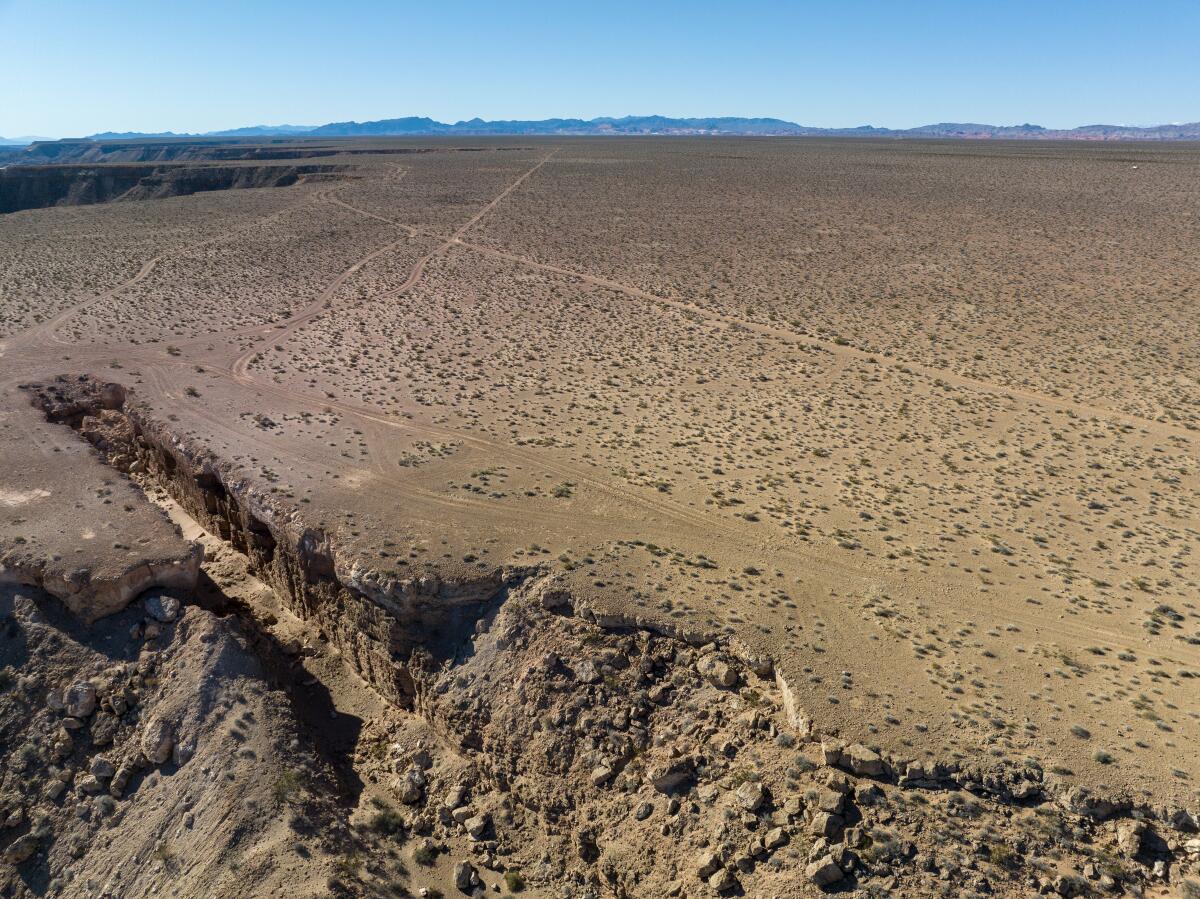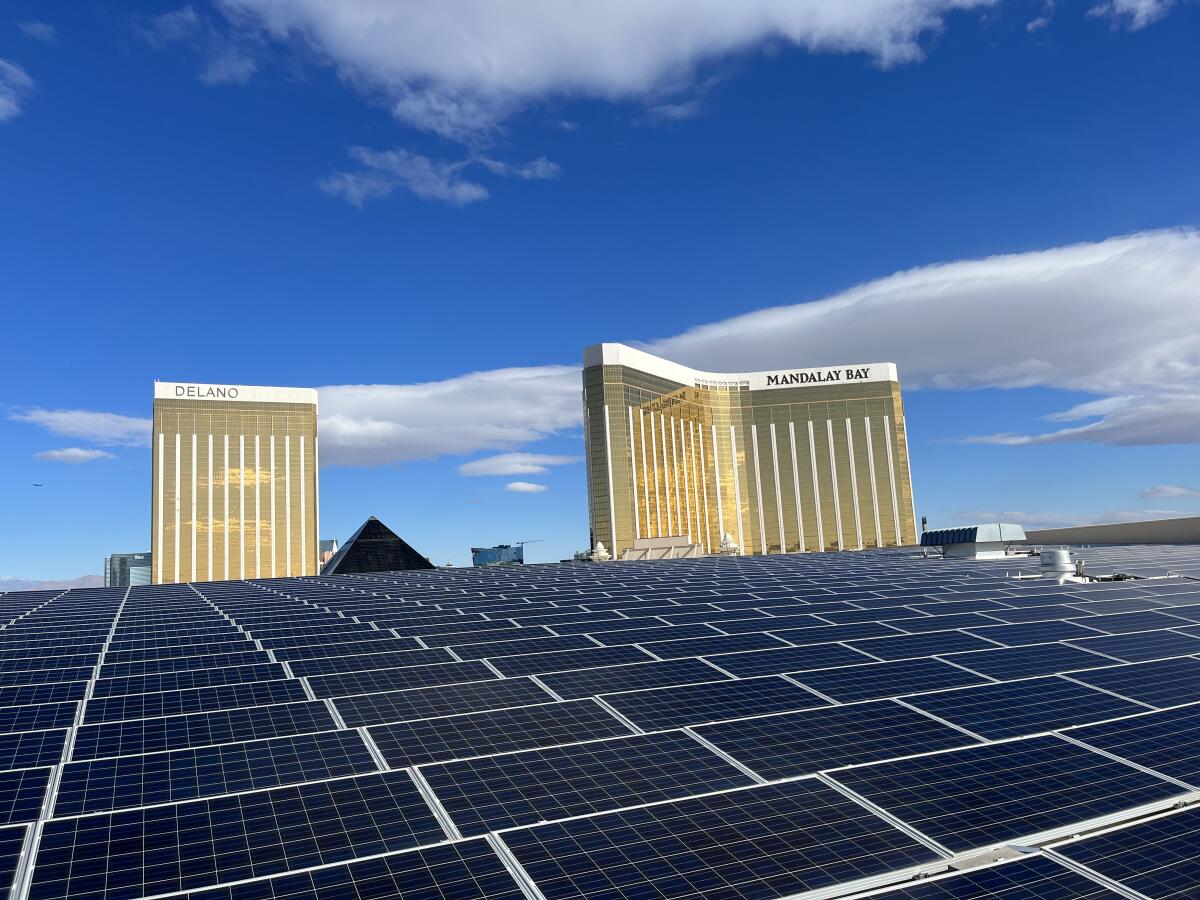How art lovers helped defeat America’s largest solar farm

- Share via
This story originally published in Boiling Point, a weekly newsletter about climate change and the environment. Sign up here to get it in your inbox.
A week ago, I stood at the edge of Mormon Mesa, a flat-topped ridge rising from the Earth northeast of Las Vegas. The Virgin River meandered through a valley below, the vegetation lining its banks forming a pale green strip across an otherwise dusty desert. The snow-capped facade of Virgin Peak, across the river in Gold Butte National Monument, dominated the horizon.
As I enjoyed the stunning view, I almost forgot why I had come here: the gaping artificial cuts in the side of the mesa.
They’re a beloved piece of landscape art. And they help explain why there are no solar panels anywhere in sight.

There are lots of reasons people have fought construction of solar farms, wind turbines and other badly needed renewable energy projects across the American West. Conservation activists argue they can destroy wildlife habitat if built in the wrong spots. Some farmers see them as a threat to agricultural economies and lifestyles. Many rural Westerners — as well as city dwellers who enjoy spending time in beautiful, undisturbed landscapes — simply don’t want to look at them.
None of those reasons are as unusual — or illuminating — as a key source of opposition to solar on Mormon Mesa.
In this case, the fight to defeat a sprawling solar project was led in part by art lovers. It’s a story whose lessons are growing more important as efforts to stop burning planet-warming coal, oil and natural gas accelerate.
In the late 1960s, landscape artist Michael Heizer blasted nearly a quarter-million tons of rock from the side of Mormon Mesa, creating two massive gashes in the tabletop formation overlooking the Virgin. Each cut is 30 feet wide and 50 feet deep.
Heizer called the newly empty space “Double Negative.” It was acquired by Los Angeles’ Museum of Contemporary Art in 1985. As then-L.A. Times art critic William Wilson wrote, “it would be easier to put the museum in the sculpture than vice versa.”

I had never heard of “Double Negative” until a few years ago, when two California-based energy developers proposed building a 14-square-mile solar project atop Mormon Mesa. Known as Battle Born, it would have been the nation’s largest solar farm, with 850 megawatts of generating capacity. Anyone visiting “Double Negative” would have had to drive through the project to get to Heizer’s artwork. The field of gleaming solar panels would have been visible from the gashes in the mesa.
Heizer fans came out in force to oppose Battle Born, joining conservationists, nearby residents and tribal groups, all of whom had their own objections. A senior director at Gagosian Gallery, which represents Heizer, told the Art Newspaper that she “hopes Nevada politicians and residents will help protect this monumental and historic example of Land Art in America.”
When I decided to visit Nevada for Part 3 of Repowering the West — my ongoing exploration of the clean energy transition and its consequences — I knew I had to see “Double Negative.” Was this remote artwork really a good reason not to build a solar farm that could help stem the climate crisis? Should these open wounds on the landscape — these trenches carved decades ago, before the passage of many modern environmental laws — stop us from preventing further destruction of the natural world?
Clearly, I was skeptical. And on first arrival at “Double Negative,” I wasn’t super impressed.
My expectations were high after the hour-and-a-half drive from Vegas, the last few miles of which involved navigating a rocky dirt road across the mesa. But getting out of the car and walking up to the first of the cuts felt anticlimactic. Yes, there was a big hole in the ground. But it felt small and insignificant compared with the size and majesty of the river valley down below.

My appreciation for the artwork grew when Times photographer Brian van der Brug sent up a drone. With a few hundred feet of aerial perspective, I could admire how strikingly Heizer’s cuts stood out against the landscape, their mesmerizingly straight edges a sharp contrast to the curving contours of the mesa’s slope dropping down toward the Virgin. A lone pickup truck and RV parked along a narrow spit of mesa — right next to the northernmost cut — offered a powerful sense of scale.
It was beautiful, in its own way. But it was also so clearly unnatural. It made me feel vaguely uncomfortable.

Adding to my unease was the history of “City,” an even larger Heizer art installation more than 100 miles northwest of here, in Nevada’s Lincoln County. It’s another beloved piece of landscape art, but it’s drawn criticism for being built on stolen Paiute land. Journalist Tristan Ahtone, a member of the Kiowa Tribe, has described it as “a monument to the power of violence.”
Yes, a solar farm on Mormon Mesa could be seen as just another act of violence. But I had trouble understanding why it couldn’t coexist with Heizer’s handiwork — especially considering the potential to reduce harm from fossil fuels.
I’ll admit I’m not much of an art person, though. So I called Bill Fox, director of the Center for Art and Environment at the Nevada Museum of Art, to ask why it would be so problematic to add a solar farm to this already altered natural space.
Fox has followed Heizer’s work for decades and recently wrote a book about the landscape artist. He told me “Double Negative” was the first time a sculpture was made out of negative space at such a large scale. Forcing people to drive through a solar farm atop Mormon Mesa to get there, he said, would fundamentally change the viewing experience.
“When you encounter that empty space across the mesa, it empties your head, as being in the desert like that always does. The amount of stimuli you’re receiving in your eyes lowers dramatically,” Fox said. “It prepares you to encounter the sculpture. You encounter that pit, and your breath is taken away.”
“Once you fill that empty space with objects, then you don’t have that experience anymore,” he added.

That all makes sense. But conflicts pop up almost anywhere solar and wind farms are proposed. If we want to keep the climate crisis from getting even worse than it already is — with wildfires, heat storms, drought and floods getting deadlier all the time, affecting marginalized communities most of all — we’ll need a to build a huge amount of clean energy infrastructure.
With that reality in mind, couldn’t art lovers learn to live with solar panels at their backs while viewing “Double Negative”?
For me personally, it’s an easy question to answer. But it’s also a question of values, as are most clean energy conflicts.
If you’ve dedicated your life to protecting endangered animals and plants, of course you might object to a wind farm disrupting their habitat — even if that renewable energy could help end an extinction crisis driven in part by climate change.
If you’re a fourth-generation farmer hoping your kids will follow in your footsteps, of course you might be troubled by neighboring growers selling out to solar companies — even if rising global temperatures are sapping your water supplies.
And if you love landscape art? Then you might feel Mormon Mesa is a terrible spot for industrial energy infrastructure.
“You can put a solar farm in many different places. You can only put ‘Double Negative’ in a few places,” Fox said.

In some ways this is mostly a thought exercise. Faced with fierce public opposition, the companies behind the Battle Born solar farm withdrew their application to the federal Bureau of Land Management in 2021, canceling the project.
Art lovers weren’t the only critics. Conservationists said Battle Born would destroy prime habitat for desert tortoises. Nearby small-town residents said the panels would disrupt popular pastimes such as off-roading and skydiving. Tribal groups objected too.
But even if “Double Negative” alone doesn’t explain the demise of this solar project, it crystallizes the difficulties we’re going to face as a nation confronting the climate crisis. The Inflation Reduction Act, signed by President Biden, includes big financial incentives for renewable energy. But all the money in the world won’t slow the planet’s warming if lawsuits, land-use restrictions and other avenues for local opposition make it impossible to build the necessary infrastructure.
Critics of sprawling solar and wind farms say we can solve climate change by putting solar on rooftops and parking lots. I’ll explore that idea in Part 3 of Repowering the West, focused on my travels last week through Las Vegas and the surrounding desert.
While I work on that story, please consider subscribing to The Times to support our journalism. If you’re not yet convinced, go read Part 2 of Repowering, about California’s Imperial Valley. It’s now open to everyone, regardless of whether you subscribe.

As we left “Double Negative” and drove back across Mormon Mesa, I thought about the Virgin River — how it flows through Zion National Park upstream from here, carving the famous Narrows gorge, which I’m lucky enough to have hiked. How a little ways downstream from here it empties into Lake Mead, the nation’s largest reservoir. How I would soon return home to California and turn on my tap and drink water from that reservoir, and hope we can stop it from dropping too much farther.
Keeping our water supplies from vanishing — and our homes from burning down, our bodies from overheating and our lungs from choking with smog — will require working through conflicts like the one on Mormon Mesa. Maybe not every solar farm or wind turbine proposed by a profit-seeking developer needs to be built. But some of them do. And fast.
And if you ask me? Maybe a field of solar panels would make it harder to enjoy “Double Negative” as Heizer intended. But there’s no way it would diminish that spectacular view of the Virgin River, bringing life to the desert and cities far beyond.
On that note, here’s what else is happening around the West:
COLORADO RIVER IN CRISIS

Last week, Times water reporter Ian James took the reins of this newsletter and offered a behind-the-scenes look at his new series, Colorado River in Crisis. Since then, the rest of the series has published. It’s powerful journalism that gets at the heart of one of the most important challenges for tens of millions of people across the western U.S. Here are the latest stories:
- In California’s Imperial Valley, farmers brace for a future with less Colorado River water
- How Las Vegas declared war on thirsty grass and set an example for the desert Southwest
- Why desert golf courses and artificial lakes remain untouched by the Colorado River crisis
- ‘A living spirit’: Native people push for changes to protect the Colorado River
- The river’s end: Amid Colorado water cuts, Mexico seeks to restore its lost oasis
There’s also been breaking news on efforts to prevent catastrophic declines at Lake Mead and Lake Powell. The seven Colorado River Basin states failed to meet a federal deadline for agreeing to reduced water deliveries — but six of the seven states, minus California, did offer a last-minute framework outlining possible cuts. Their proposal was designed in part to pressure California to come to the table, Ian James writes. Golden State farmers and cities use more Colorado River water than anyone else.
California officials responded with their own proposal to the Biden administration. Essentially, they reminded the other states that they’ve got senior water rights — and warned that if anyone tries to take too much from them, too fast, lawsuits will follow.
ONE MORE THING
Almost three years after launching this newsletter — can you believe it’s been three years?! — we’re trying something new.
Starting next week, we’ll be sending two editions of Boiling Point each week. The first, on Tuesday, will feature my usual roundup of the latest Western climate and environment news. The second, on Thursday, will feature the original writing and reporting that typically leads off the newsletter — like the above description of my trip to Mormon Mesa.
We hope you’ll enjoy hearing from me more than once. Please email back to share what you think of the new format.
That’s all for this week. We’ll be back in your inbox next week. If you enjoyed this newsletter, or previous editions, please consider forwarding it to your friends and colleagues. For more climate and environment news, follow @Sammy_Roth on Twitter.
Toward a more sustainable California
Get Boiling Point, our newsletter exploring climate change, energy and the environment, and become part of the conversation — and the solution.
You may occasionally receive promotional content from the Los Angeles Times.




